Frank's travels around Britain 2008.
Cirencester.
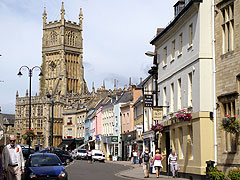 The Travelodge, literally just outside Cirencester, was lovely. Sympathetically
built out of Cotswold stone, with a modern Little Chef & a Somerfield shop
running the service area. It's normal room rate said £89 in the reception area!
Well maybe it wasn't worth that much!
Unfortunately, the miserable staff let it down a bit.
You know those people, thinking they are really too good for this job, but living
in an area of the rich & privileged & they may find their aspirations hard to
live up to!
The Travelodge, literally just outside Cirencester, was lovely. Sympathetically
built out of Cotswold stone, with a modern Little Chef & a Somerfield shop
running the service area. It's normal room rate said £89 in the reception area!
Well maybe it wasn't worth that much!
Unfortunately, the miserable staff let it down a bit.
You know those people, thinking they are really too good for this job, but living
in an area of the rich & privileged & they may find their aspirations hard to
live up to!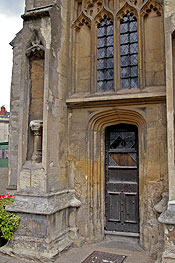
Once again the weather was very kind. I think it is because England changes it's weather every ten minutes, I just get lucky with my timing.
Cirencester has it's origins in Roman times, known as Corinium it was a centre of wool trading & a major cross roads. I don't know what I expected, but it was not the Cirencester I found. Vaguely reminiscent of Chester (without the looks), it is a shopping centre full of modern buildings with a few older bits left standing. It has very posh shops aimed at polo players & the gentry in amongst the Boots, W.H.Smiths & Charity shops. The town has it's fair share of vagrants & no one seems to be walking round as the relaxed country folk they are meant to be! Ladies who lunch & shop, mix with the obviously poor & they seem to studiously ignore each other. The saddest thing to see is the church. Slap bang in the centre of town, surrounded by very close buildings & cars, it just seems to be rotting away. In the heart of the countryside, gateway to the Cotswolds, you would have thought that a combination of a lack of acid pollution & rich people would have managed to avoid such a sad sight. Unless there is an entrance that is not obvious, the main door seems locked with iron gates and it has a side door with a broken window. It looks like the stone is melting away & the whole edifice has the appearance of being derelict.
To be fair, Cirencester is a market town of long standing and it's based on
trading. It has small precincts with shops of stuff you didn't even know you needed
at prices that never go down.
Cafes with outside seating sell expensive coffee & cakes that add to the
nation's obesity. Plenty of car parking, even in
the very centre of town to make sure you come to Cirencester to shop. It's only concession to the local
building regulations seems to be is an insistence
on the stone being the traditional Cotswold colour. For some reason, four or more buildings in the centre, are
painted in pastel colours. They look so fresh & alive. How or why this came
about, I've no idea.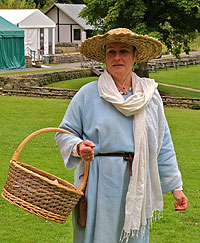
 In my opinion, the gem of the area is Chedworth Roman Villa. It's location,
peacefulness & layout is an absolute joy. The villa was discovered by accident in 1864,
when a gamekeeper found fragments of Roman paving and pottery on a bank of soil.
Over a period of two years, the
importance of these finds was recognised by James Farrer, who uncovered most of
the buildings now visible at the expense of the then
owner, the Earl of Eldon, who also provided the Museum and roofing for some of
the structures. It has always been a mystery to me that the Romans came in,
built the most beautiful houses and when they left, no one took them over! Why
didn't some English tribal chief just move in & live in luxury? It wasn't
destroyed, the floors, heating & water were left working. It was not only unused, it rotted away so much that it had to be "discovered" under thick layers
of earth. Maybe they told me once but I didn't pay enough attention at my
history lessons at school!
In my opinion, the gem of the area is Chedworth Roman Villa. It's location,
peacefulness & layout is an absolute joy. The villa was discovered by accident in 1864,
when a gamekeeper found fragments of Roman paving and pottery on a bank of soil.
Over a period of two years, the
importance of these finds was recognised by James Farrer, who uncovered most of
the buildings now visible at the expense of the then
owner, the Earl of Eldon, who also provided the Museum and roofing for some of
the structures. It has always been a mystery to me that the Romans came in,
built the most beautiful houses and when they left, no one took them over! Why
didn't some English tribal chief just move in & live in luxury? It wasn't
destroyed, the floors, heating & water were left working. It was not only unused, it rotted away so much that it had to be "discovered" under thick layers
of earth. Maybe they told me once but I didn't pay enough attention at my
history lessons at school!
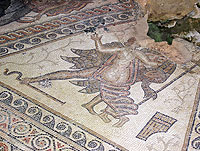 The house was begun
around 120AD & lasted about 300 years. It has two bath houses with Turkish,
sauna & normal bathing rooms. These & the latrines were served by a natural spring above the
river Coln. There was a Shrine pool at the top of the site, still there with its
trickle of spring water & it's family of tadpoles. The villa is literally in the middle of nowhere, about ten miles north of
the town centre, the journey there is through fields & woods,
The house was begun
around 120AD & lasted about 300 years. It has two bath houses with Turkish,
sauna & normal bathing rooms. These & the latrines were served by a natural spring above the
river Coln. There was a Shrine pool at the top of the site, still there with its
trickle of spring water & it's family of tadpoles. The villa is literally in the middle of nowhere, about ten miles north of
the town centre, the journey there is through fields & woods,
 up
very narrow lanes until you find it sitting
at the top of a valley. Sipping a drink in this peaceful place, where the only noises are those of
the few visitors, is pure magic. I would imagine that to waken there to the
sound of the
bird's dawn chorus would be something to experience. Built at the top of the valley,
it was obviously owned & extended by a few very rich Romans! The mosaics, covered by huts, are
stunning. So
fresh & in such good condition. The heated rooms & wall layouts make it clear
how it was laid out & how it worked so well.
up
very narrow lanes until you find it sitting
at the top of a valley. Sipping a drink in this peaceful place, where the only noises are those of
the few visitors, is pure magic. I would imagine that to waken there to the
sound of the
bird's dawn chorus would be something to experience. Built at the top of the valley,
it was obviously owned & extended by a few very rich Romans! The mosaics, covered by huts, are
stunning. So
fresh & in such good condition. The heated rooms & wall layouts make it clear
how it was laid out & how it worked so well.
I just loved the fact that about 1900 years ago a rich Roman decided that
this was the site for his English home. He used the surroundings & natural water
supply to give him a truly luxurious home. The future owners developed it and had all you need to
live there for 300 years in splendour. Today in 2008, the National Trust can't
have a proper cafe or restaurant ... because it has still not got mains water!
It is a pleasure to visit here. It was wasn't packed with people on this quiet
sunny day. A kindly person was dressed as a Romano-British lady of some 1700
years before. I know they put on "Living History" displays & they would be very interesting but
the peace of the location made it worth while spending hours wandering around
this lovely place lost in the thoughts of an age long gone.
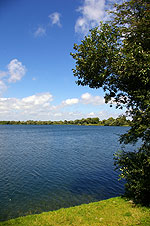 To
the south of the town there is an area of lakes, made by digging out gravel, called the Cotswold
Water Park. It is full of wild life. There are so many lakes that each one is
set up for different requirements, peace & quiet, water sports, walking and fishing. While drinking a
coffee in the sunshine, the most enormous Chubb swam past within feet of me. Swans, ducks &
Grebes where all over the place with their youngsters. It had lots of very pleasant wood
carvings & the day I visited, a huge band of children where singing their hearts out in a tiny natural
amphitheatre. A bit like a scout jamboree without the uniforms. Talking to the
fisherman (who were everywhere!) the fishing is obviously very good. Smiles all
round. I passed firms still digging out lakes, housing outlets for holidays &
mini villages, camping outlets & sailing clubs.
To
the south of the town there is an area of lakes, made by digging out gravel, called the Cotswold
Water Park. It is full of wild life. There are so many lakes that each one is
set up for different requirements, peace & quiet, water sports, walking and fishing. While drinking a
coffee in the sunshine, the most enormous Chubb swam past within feet of me. Swans, ducks &
Grebes where all over the place with their youngsters. It had lots of very pleasant wood
carvings & the day I visited, a huge band of children where singing their hearts out in a tiny natural
amphitheatre. A bit like a scout jamboree without the uniforms. Talking to the
fisherman (who were everywhere!) the fishing is obviously very good. Smiles all
round. I passed firms still digging out lakes, housing outlets for holidays &
mini villages, camping outlets & sailing clubs.
 I think if you get to know the
area, anything you want on, by or in the water is available. £3 for a day seems
a modest amount to keep the area up to such fine standard.
I think if you get to know the
area, anything you want on, by or in the water is available. £3 for a day seems
a modest amount to keep the area up to such fine standard.
The gravel extraction
began in the area over 50 years ago. Because the water table is so high, the
first quarries were dug ‘wet’; today, however, quarries are ‘de-watered’. When
extraction is complete, all pumps are switched off and the holes fill naturally
with water. So far, 147 lakes have been made this way: almost 1,000 hectares of
open water. The gravel deposits range in depth from a few centimetres to 6
metres, and begin about 1 metre below the surface. At present, 7 mineral
companies are extracting 2 million tonnes per year from 360 hectares, with a
further 370 hectares having permission for extraction. The emerging mineral
plans propose allocating another 550 hectares for extraction. Beyond this,
there’s another 50 years supply of sand & gravel.
 Being
in the edge of the Cotswolds, I couldn't resist going back to Burton-on-the-water. I know its full of grockels (just like me) and bus loads of
grey haired old ladies
with their walking sticks & dressed in pastel shades but its so lovely. Its money that
keeps it so neat & beautiful. No lager louts, no graffiti & clean cold water to
dangle your feet in. The hint to really enjoy Bourton is stay until after 5pm. All those people just
disappear & your left alone in the evening sun, sipping coffee & listening to
the sound of the river. The local traders have sussed out their trade by now.
Food from fish & chips to hotels with £8 starters! Gift shops for your fishing net to
jewellers with rings for £4000. A note of accuracy here, there is a picture on the
Bourton website of a child fishing with a net ... I've never seen a fish in
there, ever!
Being
in the edge of the Cotswolds, I couldn't resist going back to Burton-on-the-water. I know its full of grockels (just like me) and bus loads of
grey haired old ladies
with their walking sticks & dressed in pastel shades but its so lovely. Its money that
keeps it so neat & beautiful. No lager louts, no graffiti & clean cold water to
dangle your feet in. The hint to really enjoy Bourton is stay until after 5pm. All those people just
disappear & your left alone in the evening sun, sipping coffee & listening to
the sound of the river. The local traders have sussed out their trade by now.
Food from fish & chips to hotels with £8 starters! Gift shops for your fishing net to
jewellers with rings for £4000. A note of accuracy here, there is a picture on the
Bourton website of a child fishing with a net ... I've never seen a fish in
there, ever!
The whole of this area is full of places to give pleasure. Cirencester is in Gloucestershire on the edge of the Cotswolds. It borders Wiltshire & Somerset, its near so many places, Bath, Lacock, Castle Combe, the white horses of Wiltshire. Stonehenge & Avebury aren't far away. Its hard to get lodge rooms in the area but its has to be my favourite location. The only problem is, if your not careful, you can get fat (and broke) on all those exquisite cream teas!
Links for
information on this page:
